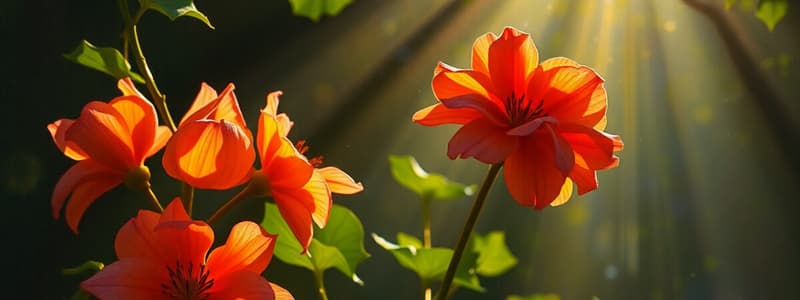Podcast
Questions and Answers
Photorespiration is a process that directly enhances the efficiency of carbon fixation in plants.
Photorespiration is a process that directly enhances the efficiency of carbon fixation in plants.
False (B)
What are the main products of photorespiration?
What are the main products of photorespiration?
2-carbon (C2) compounds instead of 3-carbon (C3) compounds
Photorespiration occurs in the ______, ______, and ______ organelles.
Photorespiration occurs in the ______, ______, and ______ organelles.
chloroplast, peroxisome, mitochondrion
Which of the following is NOT true about photorespiration?
Which of the following is NOT true about photorespiration?
Match the following terms with their corresponding descriptions:
Match the following terms with their corresponding descriptions:
Flashcards
Photorespiration
Photorespiration
A process in plants where oxygen is taken up and carbon dioxide is released, reversing carbon fixation.
Calvin Cycle Short Circuit
Calvin Cycle Short Circuit
Photorespiration short circuits the Calvin cycle, leading to the production of 2-C compounds instead of 3-C.
Wastage in Regeneration
Wastage in Regeneration
Photorespiration results in energy wastage during the regeneration of RuBP, as no sugar is produced.
Salvage Pathway
Salvage Pathway
Signup and view all the flashcards
Plant Adaptation
Plant Adaptation
Signup and view all the flashcards
Study Notes
Photorespiration and Plant Adaptation
- Photorespiration occurs when Rubisco, an enzyme crucial for photosynthesis, mistakenly binds to oxygen instead of carbon dioxide. This process reduces the efficiency of photosynthesis, leading to less glucose production.
- The stomata, tiny openings on leaves, close to conserve water in hot, arid conditions, hindering carbon dioxide uptake and leading to oxygen buildup within the leaf.
- This oxygen buildup, in turn, triggers photorespiration, using energy and resources without yielding useful products.
- Rubisco competes for the same active site with oxygen and carbon dioxide, affected by specificity and solubility.
- Photorespiration is a complex process involving multiple organelles: chloroplasts, peroxisomes, and mitochondria.
- The process involves the short-circuiting of the Calvin cycle, with carbon fixation reversed. Two-carbon compounds are recycled, instead of the usual three-carbon compounds.
- Photorespiration results in no sugar production, a significant loss of energy in regenerating RuBP (ribulose-1,5-bisphosphate), which is crucial for carbon fixation.
- Photorespiration surprisingly plays a protective role in plants. It helps neutralize damaging products from light reactions when carbon dioxide is low, preventing excess light from causing damage.
- Various plant types (C3, C4, CAM) have evolved different adaptations to minimize photorespiration:
- C3 plants rely on Rubisco to fix carbon and are less efficient in managing oxygen, vulnerable to excessive light.
- C4 plants have a specialized structure (Kranz anatomy) that increases carbon dioxide concentration around Rubisco, thus reducing competition with oxygen.
- CAM plants open their stomata only at night, concentrating carbon dioxide and reducing photorespiration during the day.
- The C4 pathway is an adaptation that helps by maintaining a high concentration of carbon dioxide around Rubisco to outcompete oxygen. This is more efficient than the C3 pathway in hot, dry conditions.
- CAM plants conserve water by opening stomata only at night.
- C3 plants are susceptible to photorespiration in high light, while C4 and CAM plants are better adapted to manage this problem.
- Different plants have different optimal temperatures for photosynthesis, and rates of photorespriation depend on the particular plant's adaptation to its environment.
Studying That Suits You
Use AI to generate personalized quizzes and flashcards to suit your learning preferences.
Related Documents
Description
This quiz explores the process of photorespiration, its impact on plant photosynthesis, and how plants adapt to arid conditions. Understand the roles of Rubisco, stomata, and the Calvin cycle in this complex process. Test your knowledge on the intricacies of plant biochemical responses.




